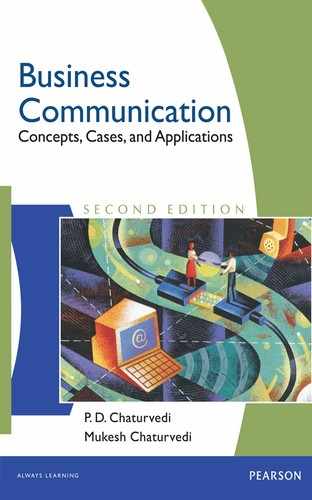Preface
What is communication? Communication is what it does—bringing people together. How does it do that? By establishing a commonness among people. The message (the verbally/non-verbally developed idea), the medium (the carrier of the message), and the environment (the surroundings in which communication takes place) bring about this commonness, a situational relationship for a (common) purpose. This is how we would like to explain communis, the Latin origin of the word “communication”.
If communication is a social need for an individual, it is the lifeblood of an organization. If we, as individuals, communicate 70 per cent of our waking time, an organization communicates 90 per cent of its working time. If individuals communicate for their personal purpose, communication in an organization is for business purposes. Thus, communication plays a crucial role in an organization, bringing all aspects of the business together—employees, customers, suppliers, intermediaries, the public, and so on.
Working people communicate at three levels: personal, social, and professional. We could also call these the three spheres of communication. We have a natural ability to adapt to the communication requirements of each of these spheres. However, with time, some of us become more and more fixed in our style of communication and tend to use the same style across the three spheres. What does our tendency to be flexible or rigid across the three spheres of communication depend on? Does it depend on how conscious we are at a particular level, and for how long? For example, if someone communicates more consciously for most of the time at the workplace, would they not become more formal in their style for the rest of the day and spheres as well?
Flexibility in our communication helps us adapt to the situational requirements faster, which results in efficient communication, and efficient communication translates into less time and effort in getting ready to communicate appropriately at a particular level. So, consciousness gives control, which, in turn, helps develop flexibility and makes our communication effective and efficient.
Our contention is that 90 per cent of us are not conscious of our communication 90 per cent of the time. And those of us who are conscious about our communication, are more conscious of what we communicate than how we communicate. Business Communication prepares students for effective communication at the workplace by focusing on how to communicate in business situations—how to recognize the techniques that help in communicating a message accurately, how to handle intercultural situations that require thoughtful communication, how to use appropriate words and an effective tone for writing effectively, and so on. We hope that the numerous exhibits, Communication Snapshots, cases, samples, and questions included in this edition of Business Communication will help students master the art of communication by learning to be more conscious of their communication and developing a flexible and efficient communication style.
We shall be happy to receive feedback from readers at [email protected] and [email protected].
ORGANIZATION
The second edition of Business Communication is a result of our experience in teaching, training, and consulting with the help of the first edition over the last six years. This includes areas such as language skills, report writing, technical writing, communication skills, presentation skills, negotiation skills, personality development, and marketing communication. Most of the concepts, cases, and applications presented in this edition are thoroughly examined and tested with groups of students, executives, and academics.
The book is divided into four parts. Part I, Theory of Business Communication, introduces the profile of an effective communicator and goes on to discuss the nature and process of communication (Chapter 1), organizational communication (Chapter 2), and intercultural communication skills (Chapter 3).
Part II, Forms of Business Communication, deals with the oral, non-verbal and written modes of communication. In addition to the chapters on oral communication (Chapter 4), conversation skills (Chapter 05), non–verbal communication (Chapter 7), and written business communication (Chapter 8), listening (Chapter 6) is also discussed in this part.
Part III, Types of Written Business Communication, deals with a crucial aspect of communication in most business situations. This part provides a detailed discussion on how to write business letters, memos, and e-mails (Chapter 9), and also has an exclusive chapter on report writing (Chapter 10). A sample report is included at the end of the book in Appendix 3.
Part IV, Applications of Business Communication, brings together most of the relevant areas of application in business communication—presentation skills (Chapter 11); negotiation skills (Chapter 12); business etiquette (Chapter 13); CVs, personal interviews, and group discussions (Chapter 14); writing a summer project report (Chapter 15); and written analysis of cases (Chapter 16). Chapter 14 has been specially developed for job aspirants, and Chapters 13 and 16 cover topics that are becoming an essential component of business curricula in leading business schools the world over.
The appendix on grammar, English usage, and style (Appendix 1) addresses some important aspects of business communication, such as the rules of grammar, common errors in English, and documentation styles. By practising the exercises in this appendix and spending time on the rules and styles, students can produce impeccable written reports and documents. The appendix on the research process (Appendix 2) supplements Chapter 10, “Report Writing”, by providing the basics of the investigation process that a student needs to indulge in before formulating a report. Further, Appendix 3, “A Sample Report”, also adds to the information given in Chapter 10 by illustrating how a report is written.
THE TEACHING AND LEARNING PACKAGE
A full range or resources that support teaching and learning are available on the companion Web site of this book, www.pearsoned.co.in/PDChaturvedi. These include:
- PowerPoint lecture slides that provide an overview of the key concepts, figures, and guidelines in each chapter.
- An instructors’ manual that provides teaching notes and helps instructors approach difficult concepts in each chapter.
- mQuest, an easy-to-use application that can be used to revise concepts and definitions and to take quizzes on cell phones.
